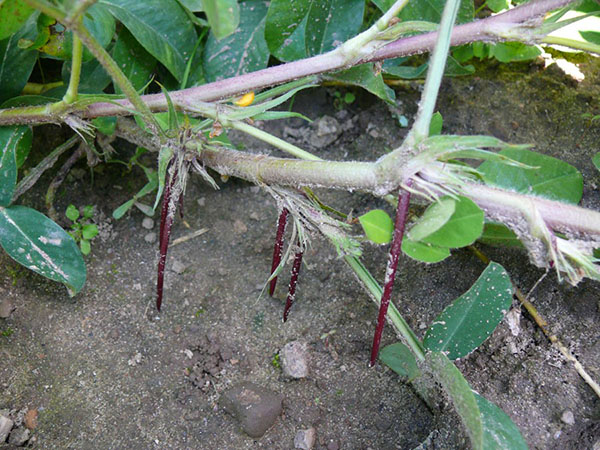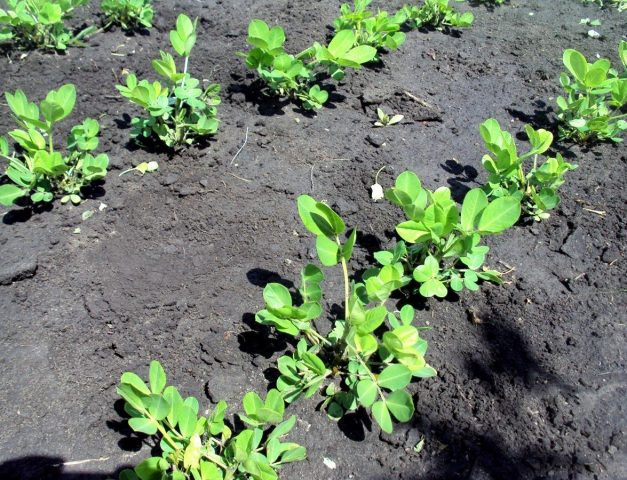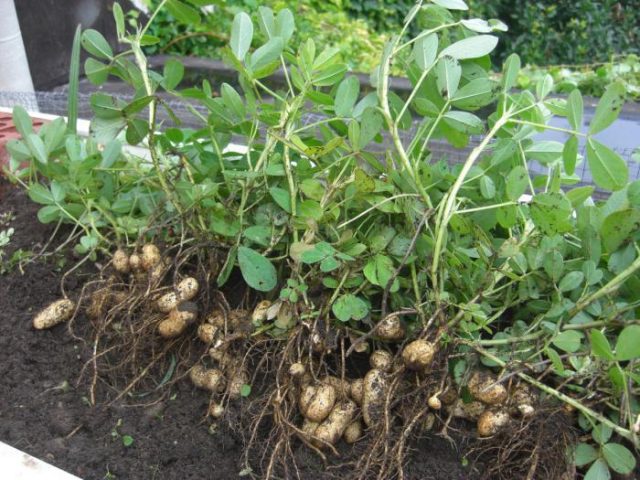Content
The middle zone of Russia, and especially the south, is quite close in terms of basic conditions to those regions where peanuts grow. On an industrial scale, the crop can be grown in areas where there is no early fall frost. At home, amateurs grow peanuts even on windowsills.
What family are peanuts
The plant is classified as belonging to the legume family, genus Peanuts. In everyday life, the culture is also called a peanut because of the peculiarities of the final phase of its development. To ripen, the resulting pods, or in botanical terminology, beans, with future grains, tilt to the ground, gradually penetrate the soil. When harvesting, the beans are dug up.
Description of the peanut plant
An annual vegetable plant, which self-pollinates, rises above the soil as a lush green bush up to 60-70 cm.Rotal roots with many shoots provide sufficient nutrition for upright stems, which are found in different varieties of peanuts:
- pubescent or naked;
- with slightly protruding edges;
- with branches that go up during flowering or descend after the formation of bean buds.
Alternate, pubescent leaves of different lengths: 3-5 or even 10-11 cm. Consist of several pairs of oval leaf blades, with a slightly pointed tip.
Pedicels emerge from the axils of the leaves, bear 4-7 flowers of the moth type, which is typical for legumes, which include peanuts. The petals are whitish or deep yellow. The peanut flower only blooms for a day. If pollination occurs, bean ovaries begin to form. At the same time, a gynophore, a receptacle site, grows, and as the branch tilts, it grows into the ground, pulling along with it a miniature bean ovary to a depth of 8-9 cm. Schematic pictures show how peanuts grow. One bush can produce up to 40 or more beans.
Usually, the beans are formed only from the peanut flowers located at the bottom of the bush. And also from the so-called cleistogamous flowers that the plant creates underground. Apical flowers, above 20 cm from the surface of the earth, do not bear fruit. Not all gynophores with bean ovaries grow into the ground, some simply dry out.
The fruits are oblong, swollen beans, with bandages, 2-6 cm long, with a wrinkled peel of a nondescript sandy color. Each contains from 1 to 3-4 bulky seeds. Grains from 1 to 2 cm, oval, with a reddish-brown husk that easily separates after processing. The seeds consist of two hard cream-colored cotyledons.
Where do peanuts grow?
The original leguminous plant spread throughout the world from the South American territory, where Bolivia and Argentina are now located.
Where peanuts grow in Russia
The culture is becoming more and more popular, including in temperate regions. The ripening period for different varieties of peanuts, from 120 to 160 days, is acceptable for some Russian regions. The main conditions for growing legumes are a sufficient amount of light, heat, moderate humidity. Where summer temperatures do not drop below + 20 ° C, and there are no early autumn frosts, peanuts grow well. If the thermometer readings are below the recommended ones, development slows down until the death of the plant. Hobbyists grow peanuts in harsher conditions using a variety of effective shelters.In areas with warm summers, peanut seeds ripen by the end of September, early October, showing a yield of 1-2 t / ha, depending on the agricultural technology used.
In the world
Peanuts grow on large agricultural areas in many countries. First introduced to Spain, the culture takes root in tropical Africa, where it becomes a valuable nutritious product. Here, on the territory of modern Congo, Senegal, Nigeria, they learned to extract vegetable oil from peanut seeds. Gradually, peanuts from the legume family, which grows well on poor soils, spread throughout the countries of Southeast Asia, and ended up in North America. Peanuts have gained particular popularity in the United States since the beginning of the 19th century. After 100 years, many of the areas previously occupied by cotton ended up under peanuts, which are also processed for technical purposes.
The largest areas cultivated for peanuts are in India, China, Indonesia and other countries in the region. Culture is also of prime importance for the economy of a number of African countries. Peanuts grow on an industrial scale in the USA, Mexico, Argentina, Brazil. A specific agricultural technique has been developed in the form of various fertilizers and growth stimulants, which helps to accelerate the development of the gynophore, reduce the number of underdeveloped ovaries and increase the yield.
How a peanut grows
For the successful cultivation of a tropical legume culture, the sunniest place without the slightest shade is chosen on the site. How the peanuts grow can be seen in the photo. In the nature of Russia the plant does not spread independently. A short warm period with temperatures above + 20 ° C forces lovers of exotic vegetables to grow them through seedlings. The thermophilic peanut also grows in Russia.
Landing
In the south, crop seeds are sown when the soil warms up to 14-15 ° C. According to the phyto-calendar, this period coincides with the flowering of acacia. Sprouts develop quickly when warm at a temperature of + 25-30 ° C.
For successful cultivation in temperate climates, they adhere to the following requirements:
- light soils are preferable - sandy loam, loam, with good aeration, neutral acidity;
- nutrition for the plant is provided by the autumn introduction of humus or rotted compost;
- do not plant on those plots where other legumes grew last year;
- holes for peanut seedlings are prepared 10 cm deep;
- between the lush bushes of a legume plant, an interval of up to 50 cm is observed.
For industrial crops in the south, row spacings up to 60-70 cm are adhered to, with a distance between plants of 20 cm. Peanut seeds are planted to a depth of 6-8 cm.
Experienced vegetable growers select varieties of leguminous plants, zoned for the steppe and southern parts of the forest-steppe belt of the European continent of the Black Sea zone. In the conditions of the Russian climate, the following varieties of peanuts are successfully growing:
- Klinsky;
- Stepnyak;
- Accordion;
- Krasnodarets;
- Adyg;
- Valencia Ukrainian;
- Virginia Nova.
Care
From the beginning of the growth of peanut seedlings, the crops are watered every 2 weeks. In caring for peanuts in dry weather in the phase of flowering and the formation of ovaries, regular watering every other day with the obligatory subsequent loosening of the soil plays an important role. In the evening, the plants come to life after spraying the bushes with warm water, which is carried out every other day. The best solution would be to organize drip irrigation. If it rains, at least irregularly, the zoned varieties grow well without watering, since the peanut is drought-resistant initially. But during the period of heavy rains or prolonged heavy rainfall in the middle lane, crops are covered with a transparent film. Soil, wet for a long time, can cause rotting of the fruit.Watering the peanuts is stopped a month before harvesting.
An important point of agricultural technology is hilling, which makes it possible not to lose that part of the crop that can dry out without reaching the ground. The soil is raked under the plant to a height of 5-6 cm. Reception is carried out the next day after watering or rain several times during the growing season:
- 9-12 days after the appearance of the first flower;
- 2 or 3 more times with an interval of 10 days.
In farms where peanuts grow as an industrial crop, they are fed:
- in the spring, before sowing or planting young shoots, the site is fertilized with 50 g of nitrophoska per square meter. m;
- twice a summer, they are supported with complex potassium-phosphorus preparations.
Harvesting
With the beginning of autumn, the leaves on the peanuts turn yellow. This is a sign of the ripeness of the grains. The beans must be harvested before the air temperature drops below 10 ° C. If early frosts occur, the seeds are tasteless and bitter. In the household, crops are dug with a pitchfork to keep the beans intact. They are dried for several hours under the sun, then torn off from the stems and roots, and dried in the air. In bad weather, the nuts are placed under a canopy, where the air flow passes. The beans are stored in boxes or bags in a dry, warm room where the thermometer does not show below + 10 ° C.
Peanuts are susceptible to many fungal diseases. Prophylactically adhere to the recommendations for watering plantings. With symptoms, they are treated with broad-spectrum fungicides. Also, the peanut has many pests that feed on delicate leaves and flowers: caterpillars, aphids, thrips. Wireworms damage fruits. They get rid of them by laying out baits in the pits and regularly examining them.
Conclusion
Few regions of Russia match the climate to the regions where peanuts usually grow. And yet, enthusiasts can grow a peanut in the middle lane. The seedling method will bring the ripening time closer, and the observance of the moisture regime in the soil will save the harvest.














